Eudialyte is a rare and complex cyclosilicate mineral that is primarily recognized for its vibrant and diverse range of colors, making it a favorite among mineral collectors and lapidaries. It is also valued for its unique crystal structure and the presence of various rare elements.
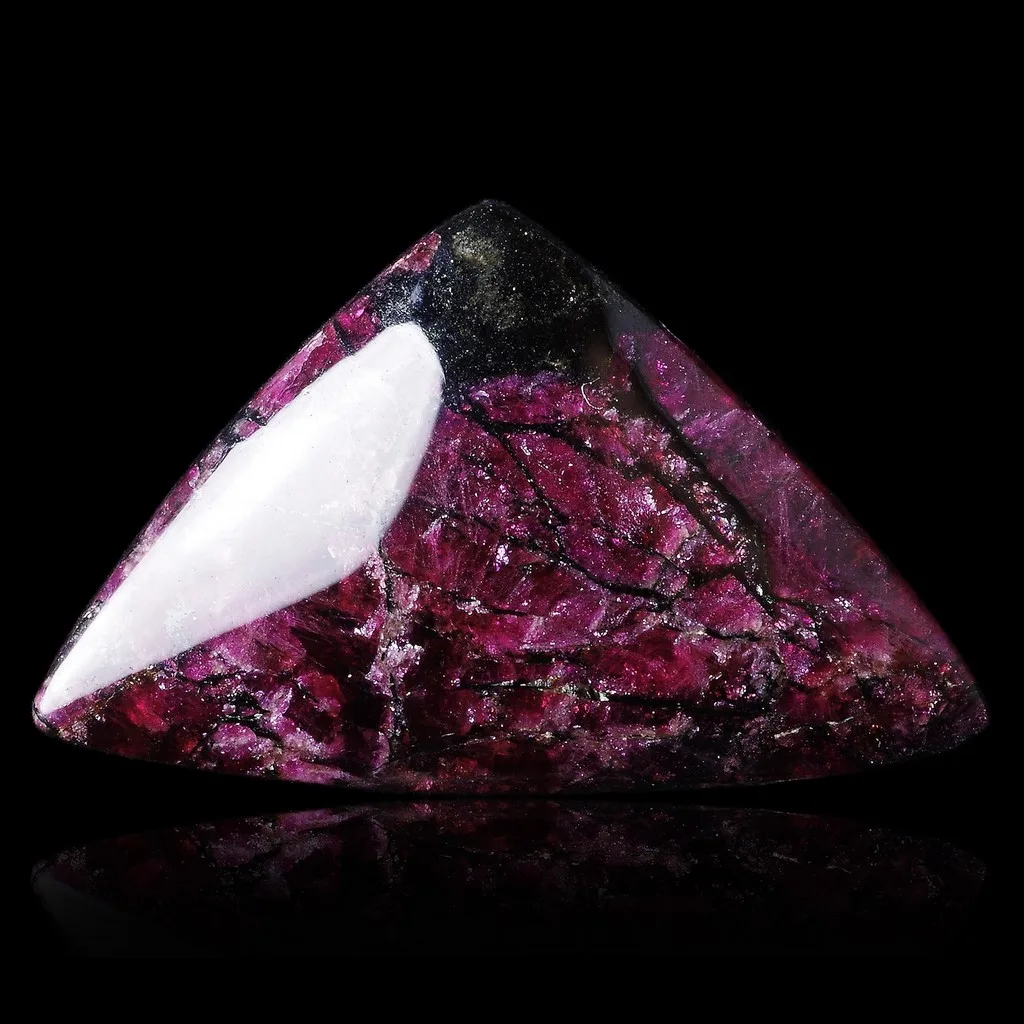
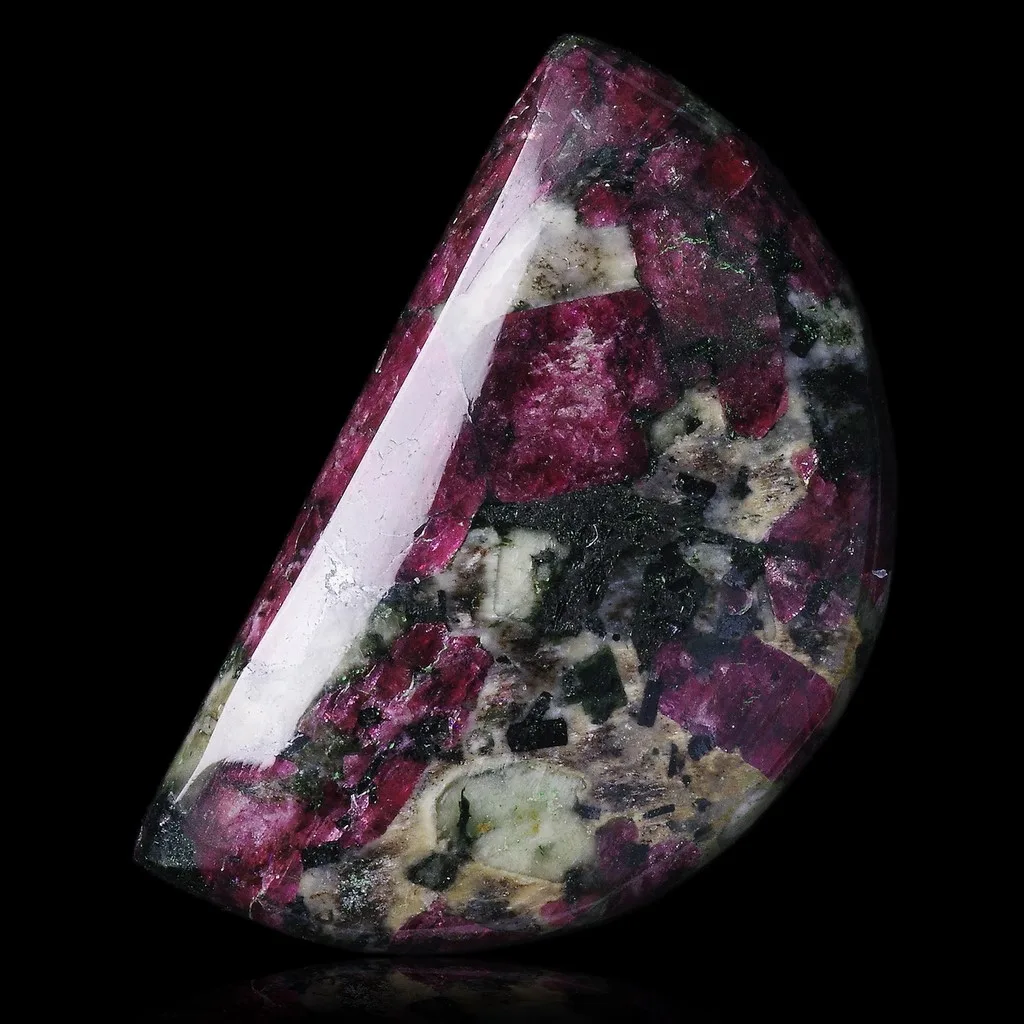
Eudialyte is a rare silicate mineral that belongs to the eudialyte group. Its chemical formula is typically represented as (Na4(Ca, Ce)2Fe3ZrSi6O17(OH, Cl)2•H2O), indicating its composition of sodium, calcium, cerium, iron, zirconium, silicon, oxygen, hydrogen, and chlorine. The exact composition can vary, as eudialyte can incorporate other rare earth elements, such as lanthanum, neodymium, and yttrium, as well as various trace elements.
Eudialyte is characterized by its striking and diverse range of colors, including shades of red, pink, brown, green, and yellow. These colors often appear in intricate and attractive patterns due to its complex crystal structure. The mineral is typically translucent to opaque and can exhibit a vitreous to greasy luster.
Eudialyte is primarily found in igneous rocks, especially alkaline syenites and pegmatites, and is often associated with other rare minerals. It has been discovered in various locations around the world, with notable occurrences in Russia, Greenland, Canada, and Norway.
Due to its rarity and aesthetic qualities, eudialyte is not only a sought-after mineral for collectors but is also used in the production of gemstones and ornamental carvings. Its name, “eudialyte,” is derived from the Greek words “eu,” meaning “well,” and “dialytos,” meaning “soluble,” alluding to its tendency to dissolve in acid.
Eudialyte’s unique combination of color, composition, and rarity makes it a fascinating subject for both geological study and artistic appreciation.
Formation, Occurrence and Distribution of Eudialyte
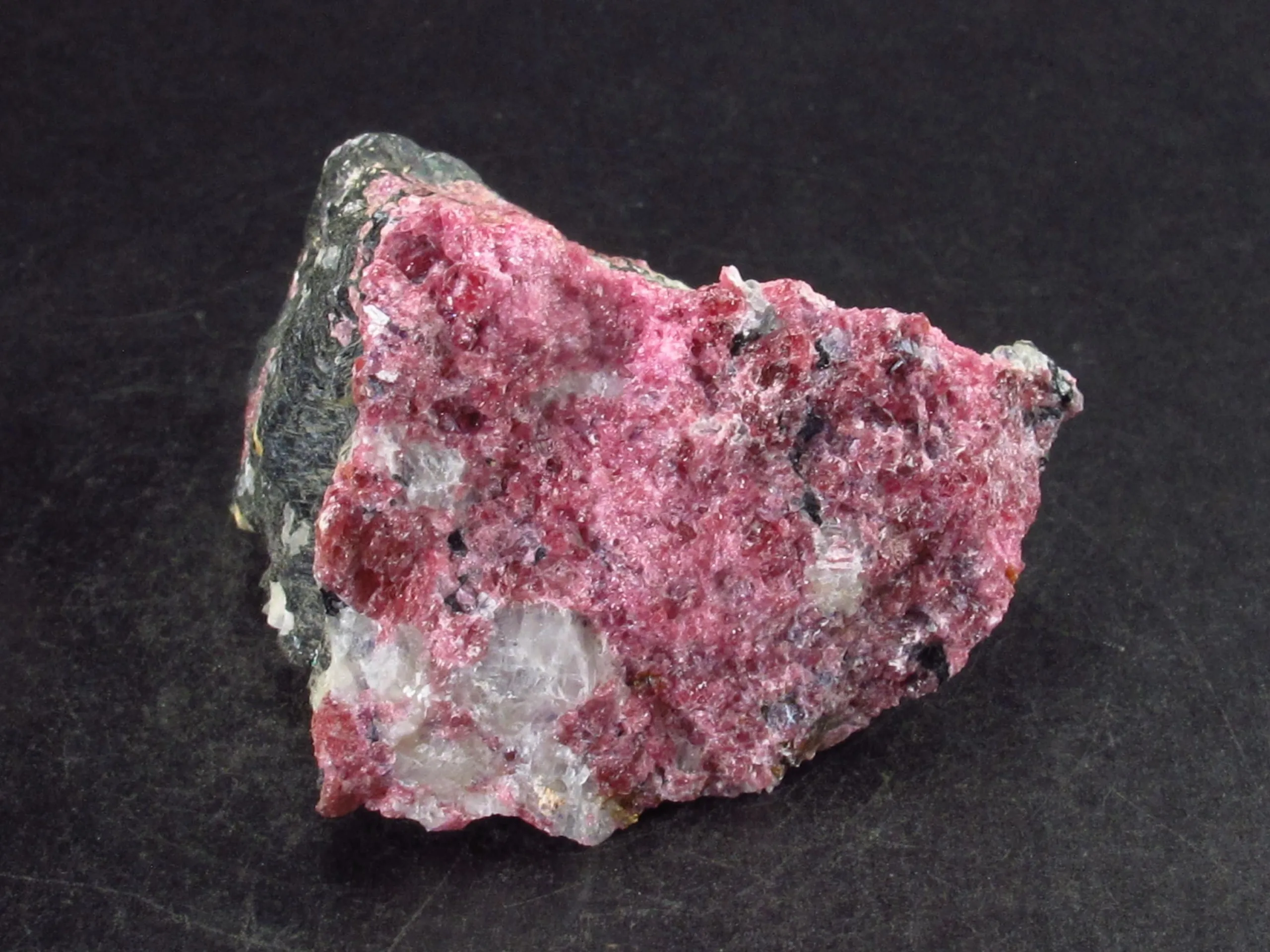
Eudialyte is a fascinating mineral with a relatively complex formation process, and it can be found in a variety of geological settings around the world. Here’s more information on the formation, occurrence, and distribution of eudialyte:
Formation: Eudialyte forms in alkaline igneous rocks, primarily through the process of magmatic crystallization. The specific conditions required for its formation involve the presence of a highly alkaline magma, which is rich in sodium, potassium, and other elements. This magma typically intrudes into existing rocks and cools, allowing the eudialyte to crystallize.
Eudialyte’s unique chemistry, including the presence of rare earth elements and the combination of sodium, calcium, cerium, iron, zirconium, silicon, and other elements, plays a crucial role in its formation. The mineral can also incorporate other trace elements, giving rise to its colorful and complex crystal structures.
Occurrence: Eudialyte is often associated with alkaline rock complexes, such as syenites and pegmatites. It is found within these igneous rocks as an accessory mineral, meaning it is not a major component of the rock but occurs alongside other minerals. The exact mineral assemblage in which eudialyte is found can vary, but it often occurs with minerals like aegirine, feldspar, and nepheline.
Notably, eudialyte is frequently associated with other rare and exotic minerals. In some cases, eudialyte deposits have been known to contain other valuable minerals, including fergusonite, loparite, and bastnäsite, which are important sources of rare earth elements.
Distribution: Eudialyte is a relatively rare mineral, and its distribution is limited to specific geological settings around the world. Some notable occurrences include:
- Russia: Eudialyte is found in the Kola Peninsula in Russia, particularly in the Lovozero Massif. The Kola Peninsula is one of the most famous and prolific sources of eudialyte, known for its beautiful and colorful specimens.
- Greenland: Eudialyte is found in several locations in Greenland, often associated with syenitic intrusions. The Ilimaussaq complex in Greenland is particularly renowned for eudialyte deposits.
- Canada: In Canada, eudialyte has been discovered in places like Mont Saint-Hilaire in Quebec and the Yukon Territory. These occurrences are known for their diverse mineralogy and aesthetic eudialyte specimens.
- Norway: Eudialyte is found in Norway, particularly in the Langesundsfjord area. These Norwegian eudialyte deposits are known for their fine crystalline specimens.
While eudialyte can be found in other locations as well, these regions are some of the most prominent sources of the mineral. Its scarcity and striking appearance make it highly sought after by mineral collectors, and it is also used in the creation of gemstones and ornamental carvings.
Physical, Chemical and Optical Properties of Eudialyte

Eudialyte is a fascinating mineral with a range of physical, chemical, and optical properties that contribute to its unique characteristics. Here’s an overview of these properties:
Physical Properties:
- Color: Eudialyte exhibits a wide range of colors, including shades of red, pink, brown, green, and yellow. These colors often occur in intricate patterns within the mineral, making it highly sought after for its aesthetics.
- Luster: Eudialyte typically has a vitreous (glass-like) to greasy luster, giving it a moderate to shiny appearance when polished.
- Transparency: Eudialyte can be translucent to opaque, with some specimens allowing light to pass through them, while others are less transparent.
- Crystal System: Eudialyte crystallizes in the hexagonal system, and its crystals are typically prismatic, tabular, or blocky.
- Hardness: Eudialyte has a moderate hardness, usually ranging from 5 to 6 on the Mohs scale. This means it can be scratched by harder minerals like quartz but can scratch softer materials.
- Cleavage: Eudialyte often exhibits poor cleavage, meaning it does not readily split along distinct planes like some other minerals.
Chemical Properties:
- Chemical Composition: The chemical formula for eudialyte is complex and can vary somewhat, but it typically includes elements such as sodium (Na), calcium (Ca), cerium (Ce), iron (Fe), zirconium (Zr), silicon (Si), oxygen (O), hydrogen (H), and chlorine (Cl). Eudialyte may also incorporate other rare earth elements and trace elements.
- Specific Gravity: The specific gravity of eudialyte can vary depending on its composition, but it typically falls in the range of 2.7 to 3.4.
- Solubility: Eudialyte is named for its tendency to dissolve in acid, particularly hydrochloric acid (HCl), which is where the “dialytos” part of its name comes from. This property helps distinguish it from many other minerals.
Optical Properties:
- Refractive Index: Eudialyte has a refractive index that ranges from approximately 1.61 to 1.74. This property contributes to its ability to exhibit varying degrees of translucency.
- Birefringence: Eudialyte typically exhibits weak to moderate birefringence, which is the splitting of light into two rays as it passes through the crystal. This optical property can sometimes help identify eudialyte under a polarizing microscope.
- Pleochroism: Eudialyte can display pleochroism, meaning it exhibits different colors when viewed from different angles. This property can enhance its visual appeal.
- Dispersion: Eudialyte has a relatively low dispersion, which means it does not exhibit the rainbow-like fire seen in some other gemstones.
Eudialyte’s physical, chemical, and optical properties make it a unique and eye-catching mineral that is highly valued by collectors and lapidaries. Its combination of vibrant colors, complex crystal structure, and the presence of rare elements contribute to its allure in both the scientific and artistic communities.
Eudialyte’s Significance
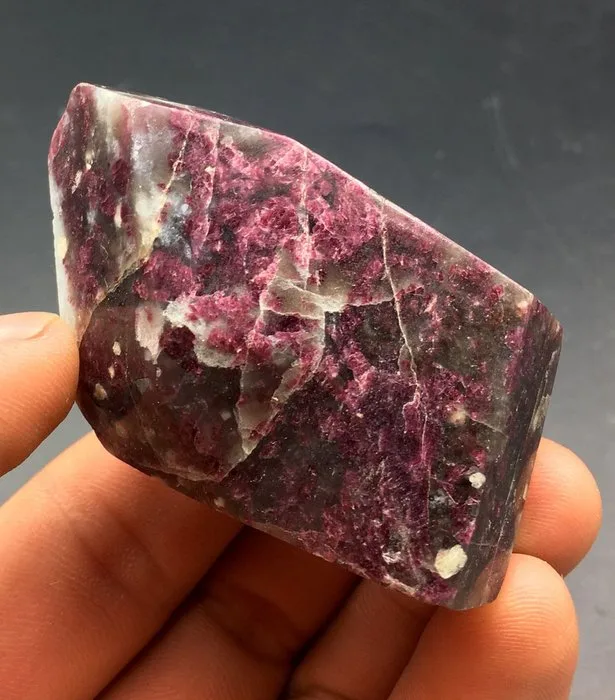
Eudialyte holds significance in various domains, including mineralogy, geology, lapidary arts, and metaphysical or spiritual practices. Here are some aspects of its significance:
- Mineralogical and Geological Significance:
- Rare Earth Elements: Eudialyte often contains rare earth elements like cerium, lanthanum, neodymium, and yttrium. These elements are crucial in various technological applications, including electronics, magnets, and catalysts.
- Indicator Mineral: Eudialyte can serve as an indicator mineral for specific geological environments. Its presence can help geologists identify certain rock types and trace the geological history of an area.
- Lapidary and Gemological Significance:
- Gemstone and Ornamental Use: Eudialyte, with its vibrant colors and unique patterns, is sometimes cut and polished into gemstones for use in jewelry. Its distinct appearance makes it a favorite among lapidaries and gem enthusiasts.
- Collectibility: Eudialyte is highly sought after by mineral collectors and enthusiasts. Specimens with exceptional color and crystal quality are prized and can command high prices in the collector’s market.
- Metaphysical and Spiritual Significance:
- Healing and Energy Properties: Some people in the metaphysical and spiritual community believe that eudialyte has healing and energy-enhancing properties. It is thought to promote self-love, emotional balance, and connection with the heart chakra.
- Balancing Energies: Eudialyte is associated with balancing energies, both within the body and in the surrounding environment. It is believed to help harmonize the energies of the physical and spiritual realms.
- Artistic and Aesthetic Significance:
- Aesthetic Appeal: Eudialyte’s striking colors, intricate patterns, and translucent to opaque qualities make it a popular choice for carvings, sculptures, and ornamental art pieces.
- Inspiration for Creativity: Artists and designers often draw inspiration from the vibrant and diverse hues of eudialyte when creating jewelry, sculptures, and other creative works.
- Scientific Significance:
- Geological Research: Eudialyte-bearing rocks provide valuable insights into geological processes, particularly those associated with alkaline igneous rocks. The study of eudialyte’s occurrence and formation aids in advancing our understanding of Earth’s geological history.
In summary, eudialyte is significant both from a scientific perspective as a unique mineral found in specific geological settings and for its cultural, artistic, and metaphysical value. Its rarity, aesthetic qualities, and potential industrial applications contribute to its multifaceted significance in various fields.
Eudialyte Varieties
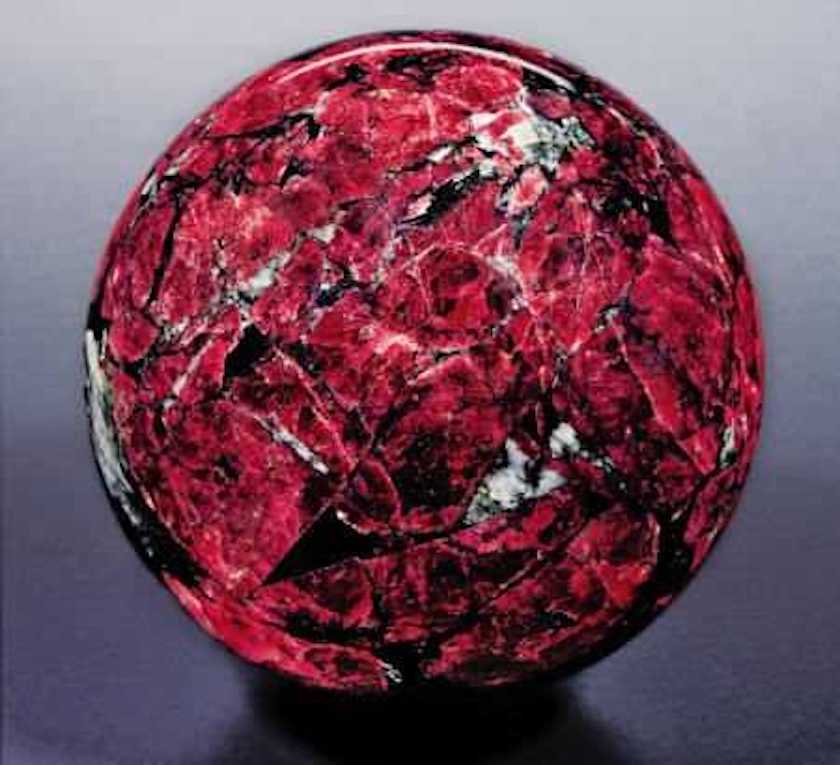
Eudialyte is a diverse mineral that can exhibit a range of variations in color, transparency, and chemical composition. Different varieties of eudialyte are often identified based on their distinct characteristics. Here are some of the notable eudialyte varieties:
- Eudialyte (General Variety):
- The general term “eudialyte” is often used to describe the mineral in its most common form. This variety can display a broad range of colors, including red, pink, brown, green, and yellow. It is typically translucent to opaque and may exhibit various patterns and inclusions.
- Rubicline:
- Rubicline is a term sometimes used to describe eudialyte specimens with a deep red or ruby-red color. These are among the most prized and valuable eudialyte varieties due to their vibrant and intense red hues.
- Yttro-eudialyte:
- Yttro-eudialyte is a variety of eudialyte that contains a significant amount of yttrium (Y) as one of its rare earth elements. This composition differentiates it from typical eudialyte. It can exhibit a range of colors but is known for its association with yttrium-rich minerals.
- Zirconian Eudialyte:
- Eudialyte may contain significant amounts of zirconium (Zr) in its composition. These varieties are sometimes referred to as zirconian eudialyte. Zirconium-rich eudialytes may have distinctive properties due to the influence of this element.
- Cerium-rich Eudialyte:
- Some eudialyte varieties are enriched in cerium (Ce), one of the rare earth elements. These specimens are often sought after for their unique chemical composition and may exhibit variations in color.
- Green Eudialyte:
- Eudialyte varieties with predominantly green coloration are less common but still valued for their distinct appearance. These may contain different ratios of elements that result in green shades.
- Cat’s Eye Eudialyte:
- In rare instances, eudialyte may display chatoyancy, which is a phenomenon that creates a cat’s eye effect. This effect is typically seen in certain cabochon-cut eudialyte specimens, which exhibit a line of light that moves across the surface as the stone is rotated.
- Rainbow Eudialyte:
- Some eudialyte specimens may display an array of colors or color zoning, creating a rainbow-like effect. These varieties can be especially prized for their captivating appearance.
It’s important to note that eudialyte’s properties and variations can be highly dependent on its geological source. Each eudialyte variety may have a unique chemical composition, which contributes to differences in color and other characteristics. Collectors and mineral enthusiasts often value these varieties for their individual traits and aesthetic appeal.
Eudialyte’s Chemical Composition

Eudialyte has a complex chemical composition that includes a variety of elements and can exhibit impurities and substitutions. Its chemical formula and structure can be broken down as follows:
Chemical Formula: The chemical formula for eudialyte is typically represented as: (Na4(Ca, Ce)2Fe3ZrSi6O17(OH, Cl)2•H2O)
Let’s break down the elements and components in this formula:
- (Na4): This part represents sodium, and eudialyte contains sodium ions.
- (Ca, Ce): Eudialyte can include both calcium (Ca) and cerium (Ce) ions, which can substitute for each other within the crystal structure.
- (Fe3): Iron (Fe) ions are present in eudialyte, typically in the trivalent (Fe3+) state.
- (Zr): Zirconium (Zr) is another essential component of eudialyte’s structure.
- (Si6O17): This part represents the silicate group, composed of silicon (Si) and oxygen (O). The arrangement of these atoms forms the silicate tetrahedra in the crystal structure.
- (OH, Cl)2: Eudialyte can contain hydroxyl (OH) and chlorine (Cl) ions. These ions are part of the anion groups that help balance the charge within the crystal structure.
- •H2O: Water (H2O) molecules may be incorporated into the crystal structure. These are typically found in the form of water vapor or as hydrated components within the mineral.
Structure: Eudialyte has a complex cyclosilicate structure. It is characterized by the formation of six-membered silicate rings, known as Si6O17 rings, which are interconnected by other elements. This arrangement results in a three-dimensional network of interconnected rings.
Impurities and Substitutions: Eudialyte’s chemical composition can vary due to the substitution of elements and impurities. Impurities may include other trace elements that are not part of the primary formula but are present in small amounts. Substitutions occur when one element replaces another within the crystal lattice, influencing the mineral’s color and properties.
Common impurities and substitutions in eudialyte include:
- Yttrium (Y): Yttrium can replace cerium (Ce) in the crystal structure.
- Lanthanum (La): Lanthanum can substitute for other rare earth elements.
- Neodymium (Nd): Neodymium may also be found as a substitution for cerium.
- Manganese (Mn): Manganese can substitute for iron in some eudialyte varieties.
- Titanium (Ti): In some cases, titanium can be present as an impurity.
- Aluminum (Al): Aluminum may replace silicon in the crystal structure, affecting eudialyte’s properties.
The specific combination of these impurities and substitutions, along with the proportions of elements in the chemical formula, contributes to the wide range of colors and characteristics exhibited by different eudialyte specimens. These variations make eudialyte a highly diverse and interesting mineral for both scientific study and aesthetic appreciation.
Applications and Uses Areas

Eudialyte is a mineral with various applications and uses in different areas, including geology, lapidary arts, and metaphysical practices. Here are some of the key application and use areas for eudialyte:
- Mineral Collecting and Geological Research:
- Eudialyte is highly sought after by mineral collectors and enthusiasts for its unique and vibrant appearance. Specimens with exceptional color and crystal quality are valued for display and study.
- Geological research: Eudialyte is significant in geology as it provides insights into the formation of alkaline igneous rocks. It can serve as an indicator mineral in geological studies.
- Lapidary Arts and Jewelry:
- Eudialyte is cut and polished into gemstones for use in jewelry. It is valued for its striking and diverse range of colors, which make it suitable for a variety of jewelry designs.
- Cabochons and faceted stones: Eudialyte can be shaped into cabochons, beads, and faceted gemstones.
- Artistic and Decorative Applications:
- Eudialyte’s unique and attractive appearance makes it suitable for use in ornamental carvings, sculptures, and other artistic creations.
- Carvings and sculptures: Artists use eudialyte to create carvings and sculptures that showcase its vibrant colors and patterns.
- Metaphysical and Spiritual Practices:
- Eudialyte is believed by some to have metaphysical properties and is used in various spiritual practices.
- Healing and energy work: Eudialyte is thought to promote self-love, emotional balance, and heart chakra activation.
- Balancing energies: Some individuals use eudialyte to balance and harmonize energies, both within the body and in the surrounding environment.
- Rare Earth Element Extraction:
- Eudialyte can contain significant amounts of rare earth elements, including cerium, lanthanum, neodymium, and yttrium. It may serve as a potential source of these valuable elements for industrial applications.
- Educational and Scientific Research:
- Eudialyte is used in educational settings and scientific research to study its crystal structure and properties. It provides insights into the composition of complex cyclosilicate minerals and the processes of alkali syenite formation.
- Aesthetic and Decorative Items:
- Eudialyte specimens and jewelry featuring this mineral are often used as decorative items, both in personal collections and in interior decor.
- Display pieces: High-quality eudialyte specimens are used for aesthetic purposes and as conversation pieces in homes, offices, and museums.
- Inspiration for Design and Fashion:
- The rich colors and patterns of eudialyte can inspire designers and artists in various creative fields, including fashion and interior design.
Eudialyte’s significance and versatility in these application areas stem from its vibrant appearance, complex chemical composition, and its presence in geological settings associated with rare minerals and geological processes. Whether appreciated for its beauty, geological significance, or spiritual qualities, eudialyte plays a multifaceted role in various fields.
Eudialyte in Jewelry and Gemology
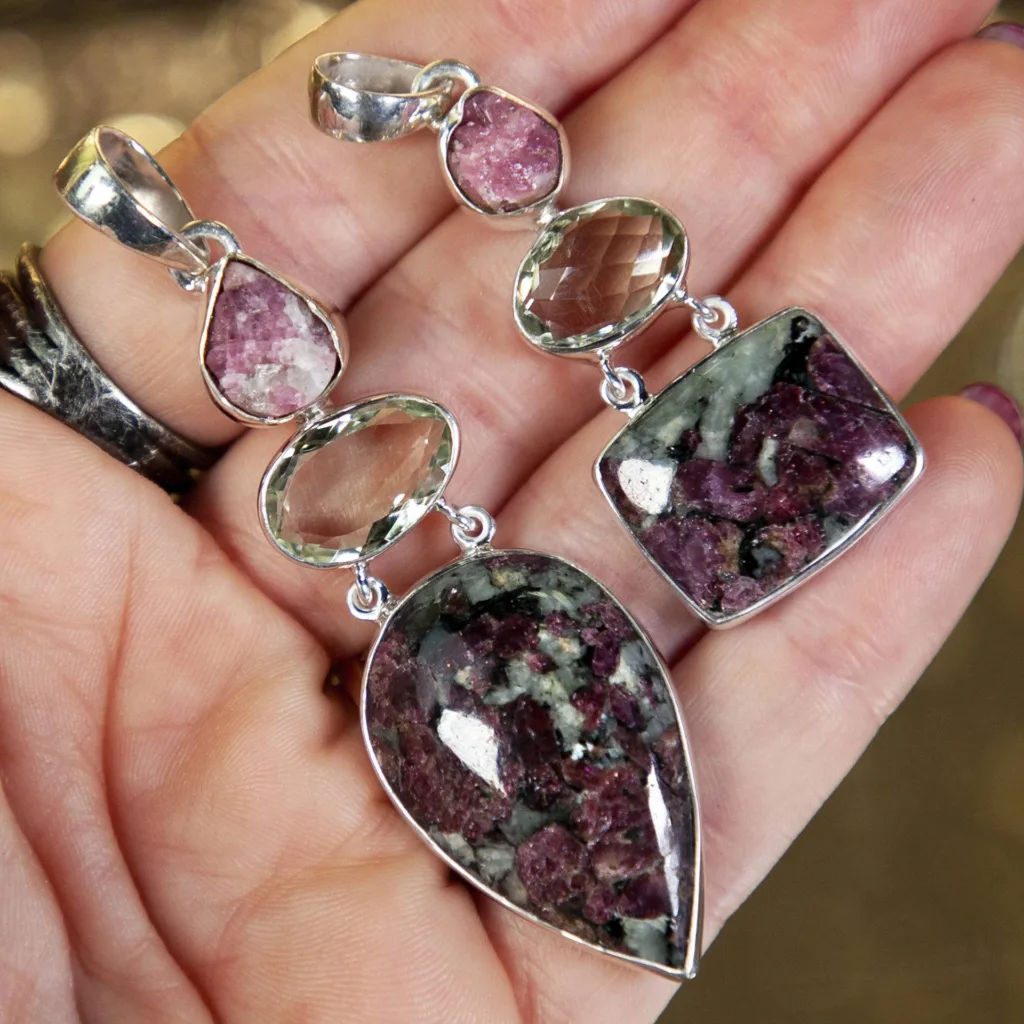
Eudialyte is valued in the field of jewelry and gemology for its unique and vibrant appearance, making it a sought-after gemstone for those looking for something distinctive and colorful. Here are some key points about eudialyte’s use in jewelry and gemology:
1. Striking Colors: Eudialyte is known for its striking range of colors, which can include shades of red, pink, brown, green, and yellow. The vibrant and varied hues make it an attractive choice for jewelry design.
2. Cabochons and Faceted Gemstones: Eudialyte is typically cut into cabochons or faceted into gemstones. Cabochons emphasize its colorful and intricate patterns, while faceted eudialyte stones can exhibit brilliance and sparkle.
3. Collectibility: Eudialyte gemstones are highly collectible, especially if they possess intense and vivid red or ruby-red coloration, which is often referred to as “rubicline.” These exceptional specimens can be highly sought after by gem enthusiasts and collectors.
4. Ornamental and Artistic Use: Eudialyte is also used in ornamental jewelry and artistic designs due to its unique and aesthetic qualities. It can be featured in one-of-a-kind and custom jewelry pieces.
5. Durability: Eudialyte has a moderate hardness, typically ranging from 5 to 6 on the Mohs scale. While it is not as hard as some other gemstones like sapphires or diamonds, it is suitable for use in jewelry that is worn with care and protection.
6. Jewelry Design Inspiration: Eudialyte’s vibrant colors and patterns can inspire jewelry designers and artisans. It can be paired with other gemstones and metals to create unique and eye-catching pieces.
7. Rarity: Eudialyte is considered a rare gemstone, and the availability of high-quality eudialyte specimens can be limited. This rarity can add to its desirability in the world of gemology.
8. Metaphysical Properties: Some individuals who believe in the metaphysical and healing properties of gemstones use eudialyte in jewelry for its perceived emotional and energetic benefits. It is thought to activate the heart chakra and promote self-love.
9. Individuality and Personal Expression: Eudialyte is often chosen by individuals who seek to express their individuality through their choice of gemstones. Its unique appearance allows wearers to make a personal statement.
10. Gemological Assessment: Gemologists and appraisers evaluate eudialyte gemstones based on their color, clarity, cut, and carat weight, similar to other colored gemstones. The gemological assessment helps determine the value and quality of eudialyte in the market.
In summary, eudialyte’s vivid colors and intricate patterns make it an appealing choice for those seeking unique and aesthetically pleasing gemstones. Whether used for its beauty, collectibility, metaphysical properties, or personal expression, eudialyte holds a special place in the world of jewelry and gemology.
Recap of key points about eudialyte
- Eudialyte is a rare cyclosilicate mineral known for its vibrant colors, complex crystal structure, and the presence of rare elements. Its name reflects its solubility in acid.
- Eudialyte is primarily found in alkaline igneous rocks like syenites and pegmatites.
- It’s associated with various rare minerals and is found in regions such as Russia, Greenland, Canada, and Norway.
- Eudialyte’s diverse range of colors and its unique combination of elements and patterns make it a fascinating and significant mineral in various fields, from geology and mineralogy to art and spirituality.
- Eudialyte exhibits a range of colors, including red, pink, brown, green, and yellow.
- It has a vitreous to greasy luster and can be translucent to opaque.
- Eudialyte belongs to the hexagonal crystal system and has a moderate hardness (5-6 on the Mohs scale).
- The chemical formula of eudialyte is complex: (Na4(Ca, Ce)2Fe3ZrSi6O17(OH, Cl)2•H2O).
- It contains elements such as sodium (Na), calcium (Ca), cerium (Ce), iron (Fe), zirconium (Zr), silicon (Si), oxygen (O), hydrogen (H), and chlorine (Cl).
- Eudialyte varieties may include rubicline, yttro-eudialyte, zirconian eudialyte, cerium-rich eudialyte, and more, each with distinct characteristics.
- Eudialyte is significant in mineralogy, geology, and lapidary arts.
- It has uses in jewelry, ornamental art, and spiritual practices.
- It may contain rare earth elements and serve as an indicator mineral in geological studies.
- Eudialyte is used in mineral collections, geological research, lapidary arts, jewelry, decorative arts, and metaphysical practices.
- It is also a source of inspiration for design and fashion due to its vibrant colors and patterns.
- Eudialyte is cut into cabochons and faceted gemstones for use in jewelry.
- Its striking colors and patterns make it a collectible and sought-after gemstone.
- Eudialyte is valued for its rarity and individuality in jewelry design.




































